Juhua Liu
Rethink Sparse Signals for Pose-guided Text-to-image Generation
Jun 26, 2025Abstract:Recent works favored dense signals (e.g., depth, DensePose), as an alternative to sparse signals (e.g., OpenPose), to provide detailed spatial guidance for pose-guided text-to-image generation. However, dense representations raised new challenges, including editing difficulties and potential inconsistencies with textual prompts. This fact motivates us to revisit sparse signals for pose guidance, owing to their simplicity and shape-agnostic nature, which remains underexplored. This paper proposes a novel Spatial-Pose ControlNet(SP-Ctrl), equipping sparse signals with robust controllability for pose-guided image generation. Specifically, we extend OpenPose to a learnable spatial representation, making keypoint embeddings discriminative and expressive. Additionally, we introduce keypoint concept learning, which encourages keypoint tokens to attend to the spatial positions of each keypoint, thus improving pose alignment. Experiments on animal- and human-centric image generation tasks demonstrate that our method outperforms recent spatially controllable T2I generation approaches under sparse-pose guidance and even matches the performance of dense signal-based methods. Moreover, SP-Ctrl shows promising capabilities in diverse and cross-species generation through sparse signals. Codes will be available at https://github.com/DREAMXFAR/SP-Ctrl.
Resolving Knowledge Conflicts in Domain-specific Data Selection: A Case Study on Medical Instruction-tuning
May 28, 2025Abstract:Domain-specific instruction-tuning has become the defacto standard for improving the performance of large language models (LLMs) in specialized applications, e.g., medical question answering. Since the instruction-tuning dataset might contain redundant or low-quality data, data selection (DS) is usually required to maximize the data efficiency. Despite the successes in the general domain, current DS methods often struggle to select the desired data for domain-specific instruction-tuning. One of the main reasons is that they neglect the impact of knowledge conflicts, i.e., the discrepancy between LLMs' pretrained knowledge and context knowledge of instruction data, which could damage LLMs' prior abilities and lead to hallucination. To this end, we propose a simple-yet-effective Knowledge-aware Data Selection (namely KDS) framework to select the domain-specific instruction-tuning data that meets LLMs' actual needs. The core of KDS is to leverage two knowledge-aware metrics for quantitatively measuring knowledge conflicts from two aspects: context-memory knowledge alignment and intra-memory knowledge consistency. By filtering the data with large knowledge conflicts and sampling the high-quality and diverse data, KDS can effectively stimulate the LLMs' abilities and achieve better domain-specific performance. Taking the medical domain as the testbed, we conduct extensive experiments and empirically prove that KDS surpasses the other baselines and brings significant and consistent performance gains among all LLMs. More encouragingly, KDS effectively improves the model generalization and alleviates the hallucination problem.
Adapting Segment Anything Model for Power Transmission Corridor Hazard Segmentation
May 28, 2025Abstract:Power transmission corridor hazard segmentation (PTCHS) aims to separate transmission equipment and surrounding hazards from complex background, conveying great significance to maintaining electric power transmission safety. Recently, the Segment Anything Model (SAM) has emerged as a foundational vision model and pushed the boundaries of segmentation tasks. However, SAM struggles to deal with the target objects in complex transmission corridor scenario, especially those with fine structure. In this paper, we propose ELE-SAM, adapting SAM for the PTCHS task. Technically, we develop a Context-Aware Prompt Adapter to achieve better prompt tokens via incorporating global-local features and focusing more on key regions. Subsequently, to tackle the hazard objects with fine structure in complex background, we design a High-Fidelity Mask Decoder by leveraging multi-granularity mask features and then scaling them to a higher resolution. Moreover, to train ELE-SAM and advance this field, we construct the ELE-40K benchmark, the first large-scale and real-world dataset for PTCHS including 44,094 image-mask pairs. Experimental results for ELE-40K demonstrate the superior performance that ELE-SAM outperforms the baseline model with the average 16.8% mIoU and 20.6% mBIoU performance improvement. Moreover, compared with the state-of-the-art method on HQSeg-44K, the average 2.9% mIoU and 3.8% mBIoU absolute improvements further validate the effectiveness of our method on high-quality generic object segmentation. The source code and dataset are available at https://github.com/Hhaizee/ELE-SAM.
GoMatching++: Parameter- and Data-Efficient Arbitrary-Shaped Video Text Spotting and Benchmarking
May 28, 2025Abstract:Video text spotting (VTS) extends image text spotting (ITS) by adding text tracking, significantly increasing task complexity. Despite progress in VTS, existing methods still fall short of the performance seen in ITS. This paper identifies a key limitation in current video text spotters: limited recognition capability, even after extensive end-to-end training. To address this, we propose GoMatching++, a parameter- and data-efficient method that transforms an off-the-shelf image text spotter into a video specialist. The core idea lies in freezing the image text spotter and introducing a lightweight, trainable tracker, which can be optimized efficiently with minimal training data. Our approach includes two key components: (1) a rescoring mechanism to bridge the domain gap between image and video data, and (2) the LST-Matcher, which enhances the frozen image text spotter's ability to handle video text. We explore various architectures for LST-Matcher to ensure efficiency in both parameters and training data. As a result, GoMatching++ sets new performance records on challenging benchmarks such as ICDAR15-video, DSText, and BOVText, while significantly reducing training costs. To address the lack of curved text datasets in VTS, we introduce ArTVideo, a new benchmark featuring over 30% curved text with detailed annotations. We also provide a comprehensive statistical analysis and experimental results for ArTVideo. We believe that GoMatching++ and the ArTVideo benchmark will drive future advancements in video text spotting. The source code, models and dataset are publicly available at https://github.com/Hxyz-123/GoMatching.
KaFT: Knowledge-aware Fine-tuning for Boosting LLMs' Domain-specific Question-Answering Performance
May 21, 2025Abstract:Supervised fine-tuning (SFT) is a common approach to improve the domain-specific question-answering (QA) performance of large language models (LLMs). However, recent literature reveals that due to the conflicts between LLMs' internal knowledge and the context knowledge of training data, vanilla SFT using the full QA training set is usually suboptimal. In this paper, we first design a query diversification strategy for robust conflict detection and then conduct a series of experiments to analyze the impact of knowledge conflict. We find that 1) training samples with varied conflicts contribute differently, where SFT on the data with large conflicts leads to catastrophic performance drops; 2) compared to directly filtering out the conflict data, appropriately applying the conflict data would be more beneficial. Motivated by this, we propose a simple-yet-effective Knowledge-aware Fine-tuning (namely KaFT) approach to effectively boost LLMs' performance. The core of KaFT is to adapt the training weight by assigning different rewards for different training samples according to conflict level. Extensive experiments show that KaFT brings consistent and significant improvements across four LLMs. More analyses prove that KaFT effectively improves the model generalization and alleviates the hallucination.
Reasoning-OCR: Can Large Multimodal Models Solve Complex Logical Reasoning Problems from OCR Cues?
May 19, 2025Abstract:Large Multimodal Models (LMMs) have become increasingly versatile, accompanied by impressive Optical Character Recognition (OCR) related capabilities. Existing OCR-related benchmarks emphasize evaluating LMMs' abilities of relatively simple visual question answering, visual-text parsing, etc. However, the extent to which LMMs can deal with complex logical reasoning problems based on OCR cues is relatively unexplored. To this end, we introduce the Reasoning-OCR benchmark, which challenges LMMs to solve complex reasoning problems based on the cues that can be extracted from rich visual-text. Reasoning-OCR covers six visual scenarios and encompasses 150 meticulously designed questions categorized into six reasoning challenges. Additionally, Reasoning-OCR minimizes the impact of field-specialized knowledge. Our evaluation offers some insights for proprietary and open-source LMMs in different reasoning challenges, underscoring the urgent to improve the reasoning performance. We hope Reasoning-OCR can inspire and facilitate future research on enhancing complex reasoning ability based on OCR cues. Reasoning-OCR is publicly available at https://github.com/Hxyz-123/ReasoningOCR.
LogicOCR: Do Your Large Multimodal Models Excel at Logical Reasoning on Text-Rich Images?
May 18, 2025Abstract:Recent advances in Large Multimodal Models (LMMs) have significantly improved their reasoning and Optical Character Recognition (OCR) capabilities. However, their performance on complex logical reasoning tasks involving text-rich images remains underexplored. To bridge this gap, we introduce LogicOCR, a benchmark comprising 1,100 multiple-choice questions designed to evaluate LMMs' logical reasoning abilities on text-rich images, while minimizing reliance on domain-specific knowledge (e.g., mathematics). We construct LogicOCR by curating a text corpus from the Chinese National Civil Servant Examination and develop a scalable, automated pipeline to convert it into multimodal samples. First, we design prompt templates to steer GPT-Image-1 to generate images with diverse backgrounds, interleaved text-illustration layouts, and varied fonts, ensuring contextual relevance and visual realism. Then, the generated images are manually verified, with low-quality examples discarded. We evaluate a range of representative open-source and proprietary LMMs under both Chain-of-Thought (CoT) and direct-answer settings. Our multi-dimensional analysis reveals key insights, such as the impact of test-time scaling, input modality differences, and sensitivity to visual-text orientation. Notably, LMMs still lag in multimodal reasoning compared to text-only inputs, indicating that they have not fully bridged visual reading with reasoning. We hope LogicOCR will serve as a valuable resource for advancing multimodal reasoning research. The dataset is available at https://github.com/MiliLab/LogicOCR.
Detect Changes like Humans: Incorporating Semantic Priors for Improved Change Detection
Dec 22, 2024



Abstract:When given two similar images, humans identify their differences by comparing the appearance ({\it e.g., color, texture}) with the help of semantics ({\it e.g., objects, relations}). However, mainstream change detection models adopt a supervised training paradigm, where the annotated binary change map is the main constraint. Thus, these methods primarily emphasize the difference-aware features between bi-temporal images and neglect the semantic understanding of the changed landscapes, which undermines the accuracy in the presence of noise and illumination variations. To this end, this paper explores incorporating semantic priors to improve the ability to detect changes. Firstly, we propose a Semantic-Aware Change Detection network, namely SA-CDNet, which transfers the common knowledge of the visual foundation models ({\it i.e., FastSAM}) to change detection. Inspired by the human visual paradigm, a novel dual-stream feature decoder is derived to distinguish changes by combining semantic-aware features and difference-aware features. Secondly, we design a single-temporal semantic pre-training strategy to enhance the semantic understanding of landscapes, which brings further increments. Specifically, we construct pseudo-change detection data from public single-temporal remote sensing segmentation datasets for large-scale pre-training, where an extra branch is also introduced for the proxy semantic segmentation task. Experimental results on five challenging benchmarks demonstrate the superiority of our method over the existing state-of-the-art methods. The code is available at \href{https://github.com/thislzm/SA-CD}{SA-CD}.
Learning from Imperfect Data: Towards Efficient Knowledge Distillation of Autoregressive Language Models for Text-to-SQL
Oct 15, 2024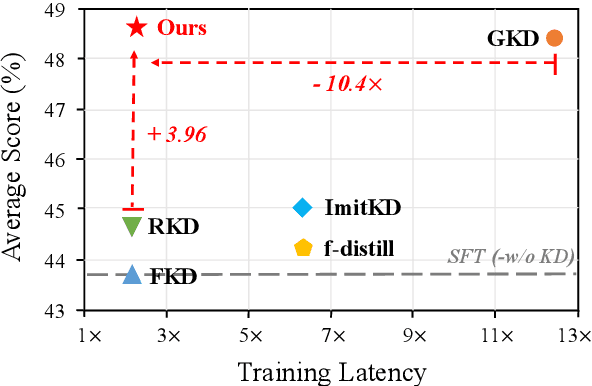
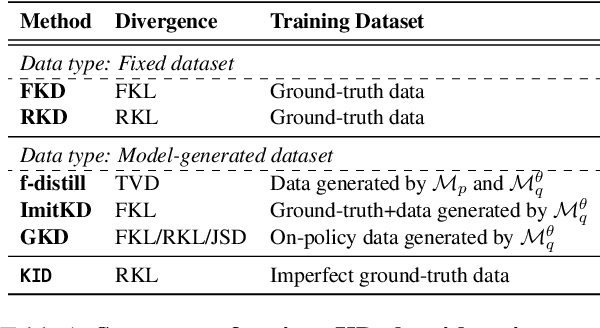
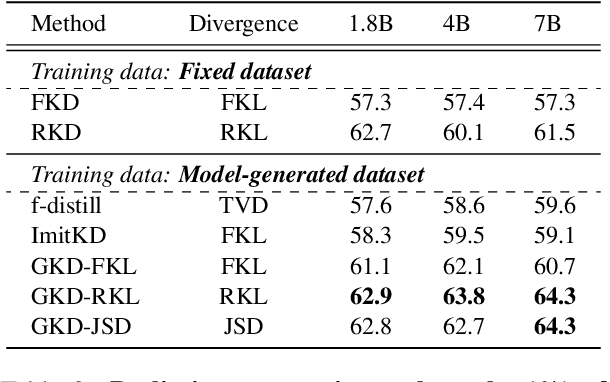
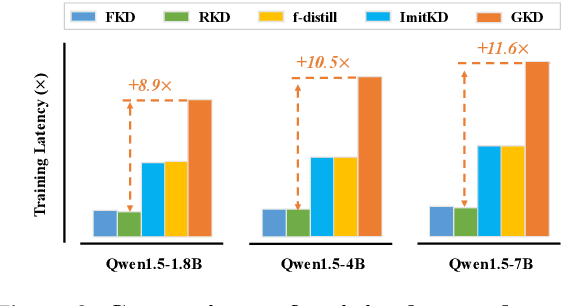
Abstract:Large Language Models (LLMs) have shown promising performance in text-to-SQL, which involves translating natural language questions into SQL queries. However, current text-to-SQL LLMs are computationally expensive and challenging to deploy in real-world applications, highlighting the importance of compressing them. To achieve this goal, knowledge distillation (KD) is a common approach, which aims to distill the larger teacher model into a smaller student model. While numerous KD methods for autoregressive LLMs have emerged recently, it is still under-explored whether they work well in complex text-to-SQL scenarios. To this end, we conduct a series of analyses and reveal that these KD methods generally fall short in balancing performance and efficiency. In response to this problem, we propose to improve the KD with Imperfect Data, namely KID, which effectively boosts the performance without introducing much training budget. The core of KID is to efficiently mitigate the training-inference mismatch by simulating the cascading effect of inference in the imperfect training data. Extensive experiments on 5 text-to-SQL benchmarks show that, KID can not only achieve consistent and significant performance gains (up to +5.83% average score) across all model types and sizes, but also effectively improve the training efficiency.
Iterative Data Augmentation with Large Language Models for Aspect-based Sentiment Analysis
Jun 29, 2024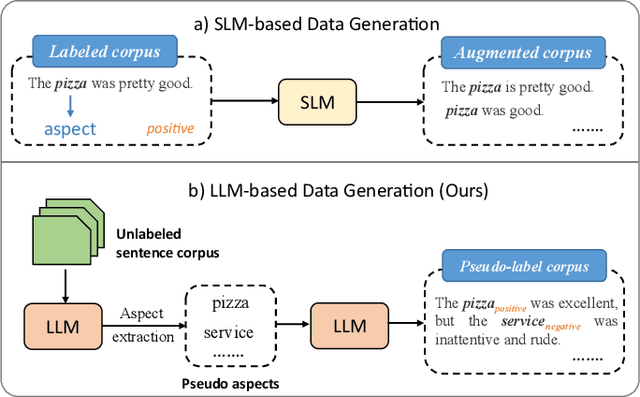
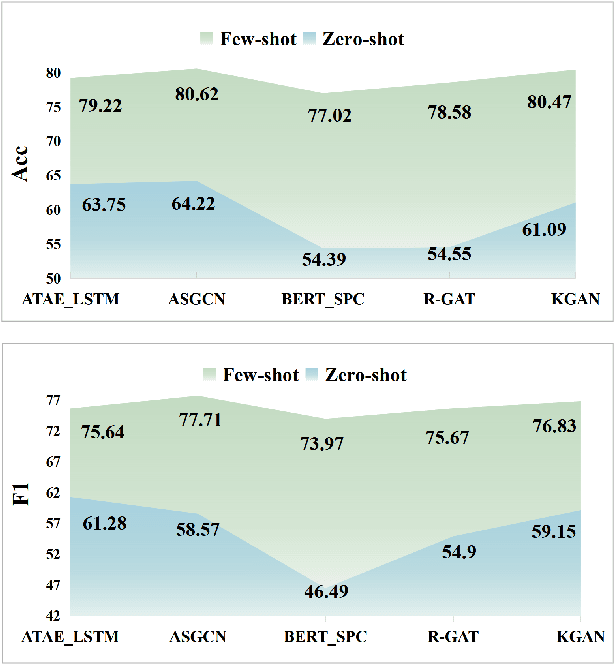
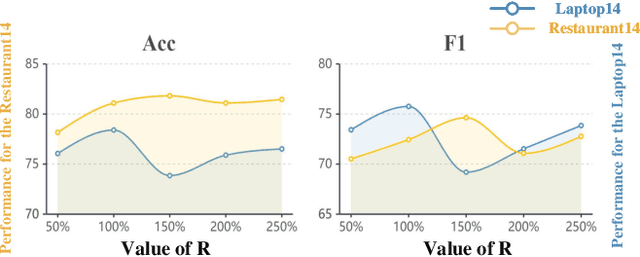
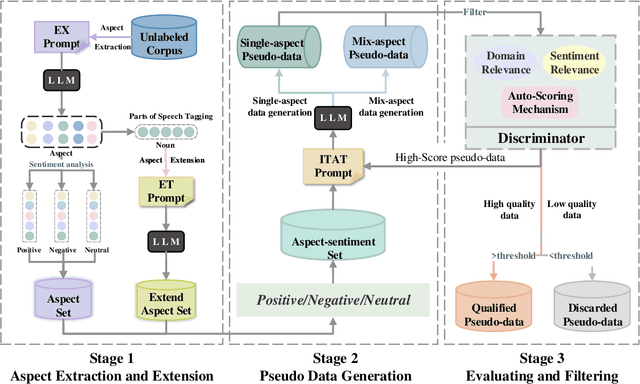
Abstract:Aspect-based Sentiment Analysis (ABSA) is an important sentiment analysis task, which aims to determine the sentiment polarity towards an aspect in a sentence. Due to the expensive and limited labeled data, data augmentation (DA) has become the standard for improving the performance of ABSA. However, current DA methods usually have some shortcomings: 1) poor fluency and coherence, 2) lack of diversity of generated data, and 3) reliance on some existing labeled data, hindering its applications in real-world scenarios. In response to these problems, we propose a systematic Iterative Data augmentation framework, namely IterD, to boost the performance of ABSA. The core of IterD is to leverage the powerful ability of large language models (LLMs) to iteratively generate more fluent and diverse synthetic labeled data, starting from an unsupervised sentence corpus. Extensive experiments on 4 widely-used ABSA benchmarks show that IterD brings consistent and significant performance gains among 5 baseline ABSA models. More encouragingly, the synthetic data generated by IterD can achieve comparable or even better performance against the manually annotated data.
 Add to Chrome
Add to Chrome Add to Firefox
Add to Firefox Add to Edge
Add to Edge